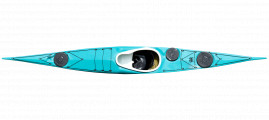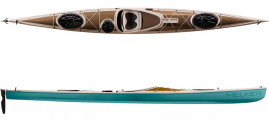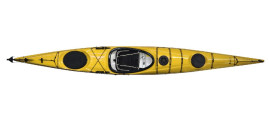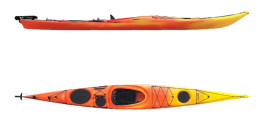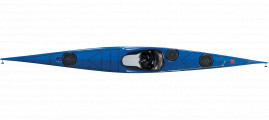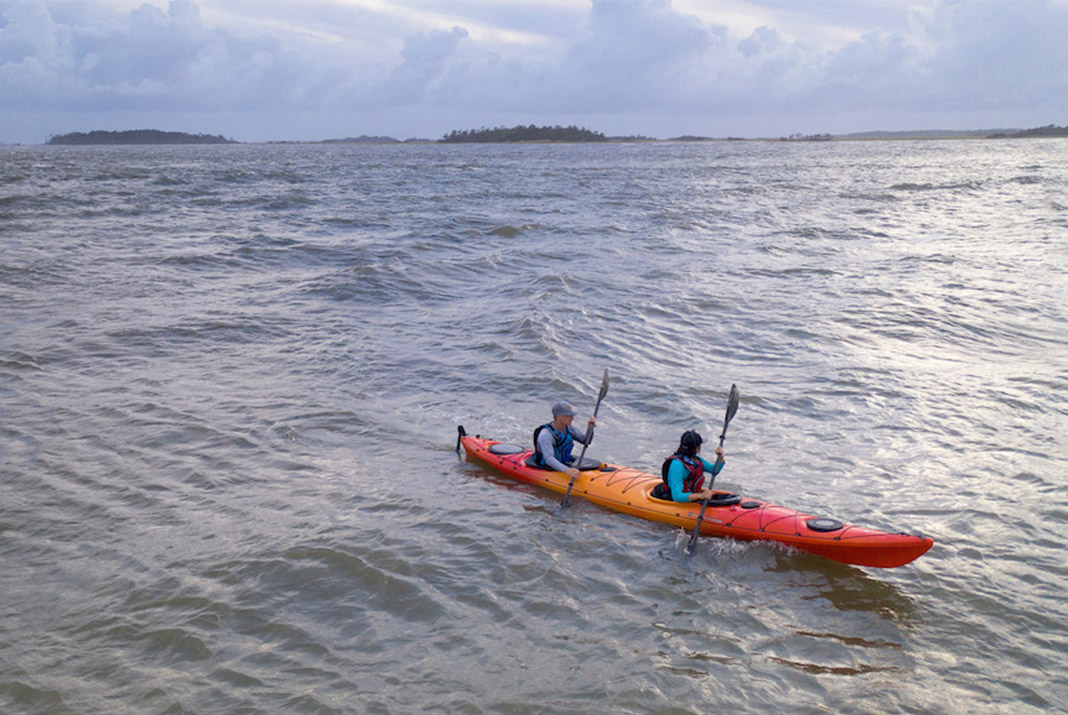What exactly are expedition kayaks? Think of an expedition as a journey taken with a purpose. It follows that any kayak in this category is designed to be taken on extended, multi-day trips, often in remote areas. Expedition kayaks open up access to wild coastlines, allowing us to travel and explore incredible spaces. Any kayak worthy of being labelled an expedition kayak needs the features and capacity necessary to do so.
In fact, most modern sea kayak designs emerged from expedition models. Frank Goodman’s “Nordkapp” kayak, designed for the British Kayak Expedition’s 1975 trip in Northern Norway, was an immensely influential design. As the world of sea kayaks has grown, sea kayaks tailored to other paddling styles such as day touring, surfing or racing, have emerged.
Still, expedition kayaking remains the soul of sea kayaking for many, and is still the reason many paddlers first get in a sea kayak. Taking longer trips is a goal of many new paddlers, who eventually graduate from a recreational or sit-on-top kayak to one more suitable for the seas.
While buying an expedition kayak there are some things to keep top of mind. Expedition kayaks are a niche group, and the boats may be harder to find than generalist kayaks. Finding the right one might require some searching, even exploration, but if you are truly in the market for an expedition kayak, you’d probably be disappointed if it were any other way.
Top picks: Best expedition kayaks for 2024
The following expedition kayaks have received the highest star ratings by reviewers in our Paddling Buyer’s Guide. See and review all expedition kayaks here.
Best Expedition Kayaks
Shop for expedition kayaks
Different types of expedition kayaks match different types of travel. Whether you are looking to spend a few days on a northern river, explore a coastal archipelago or hike into a mountain lake, there’s an expedition kayak to suit the job.
Explore our Paddling Buyer’s Guide to find specs, prices and more. Begin your search by clicking through the links below for filtered results by type or brand.
Shop by type
Hard-shell expedition kayaks
Expedition sea/touring kayaks
River expedition kayaks
Solo expedition kayaks
Tandem expedition kayaks
Expedition sit-on-top kayaks
Sit-inside expedition kayaks
Ocean expedition kayaks
Expedition kayaks with a skeg
Expedition kayaks with a rudder
Shop by brand
Shopping for a used expedition kayak?
Expedition sea kayak design hasn’t gone through dramatic changes over the years, and the boats can last decades if they are properly cared for. You may be able to find earlier versions of the best expedition kayaks of 2021 on the used market.
Like all used kayak purchases, it is best to know what type of paddling you are planning to do. The previous owner may tell you what they used the kayak for, and you can compare it to your personal paddling goals. Outfitters should be able to be similarly helpful and steer you in the right direction when you are deciding which boat from their rental fleet to purchase.
Finding one on the used market can also maximize your value if shopping on a budget. Craigslist, Facebook Marketplace or other online classifieds are good places to begin a search, but the bulk of the postings may be for recreational or day-touring kayaks. Specialized interest groups, such as a local paddling club, may be able to help you find expedition-ready boats.
When looking for a used expedition kayak, thoroughly inspect the boat, paying particular attention to the hull and hatches.
Hull
If the kayak has been used heavily, there may be some scrapes on the hull. Depending on the material, they may be cosmetic or easily fixed. Plastic kayaks are very durable, and although the abrasions may look unsightly, light scratching does not compromise the hull’s integrity.
Used fiberglass expedition kayaks may have had repair work completed on them already. An outstanding repair job would hardly be noticeable. While these are not necessarily detrimental to performance, they are helpful to note as they may indicate how well used (and cared for) the kayak was.
Hatches
The quality of the hatches is essential for an expedition kayak. Rubber hatches dry out with repeated UV exposure, so many kayak owners treat the hatches with 303 Aerospace Protectant or another protectant to extend their life. It’s an indication that the hatches have been well cared for if they feel slightly oily. If instead they are dry and cracking, replacements can be ordered from the kayak company or through a local outfitter.
The hatch coaming is the ridge where the hatches meet the kayak. On many expedition kayaks, this is a separate part that is attached and sealed to the deck of the kayak. On an extended trip, it is important to be sure that water won’t enter the hatch. Check for signs of water entering the hatches or visible gaps along where the bulkheads meet the hull as well.
For more tips on what to look for when selecting a used kayak, read our article How To Buy A Used Kayak.
Expedition kayak buying guide
While people may have differing opinions on the best sea kayak for expeditions, look to what the experts use. Chat with guides or people who take expedition-style trips in the area you wish to travel. This will help you better understand what boats are best suited for that environment and trip length.
Generally, you’ll want to look for a high-volume sea kayak made with durable materials. We’ll discuss size, materials, and design to help you understand what kind of boat will be the best for you.

Size
If you are planning to take long trips, you’ll want to be sure your kayak can accommodate all of your supplies. An expedition kayak should have ample space for tents, sleeping bags, food, safety equipment and everything else. Consider what kind of wilderness traveler you are, and if you are someone who likes to take lots of extra gear, then plan accordingly with your kayak.
We’ll get into this a bit more in the design section, but in addition to gear, make sure that you fit in the kayak. You’ll be sitting in the kayak for long periods of time, so it’s important to be in a boat that you feel comfortable in. If the kayak is too tight you risk being cramped or unstable. If it’s too loose, you will have a hard time engaging your lower body and controlling the boat.
Related to overall volume is length. Expedition sea kayaks tend to be on the long side, generally 15-17 feet for smaller paddlers, and 17-19 feet for larger ones. Notice how we didn’t give specific heights or sizes? Sea kayaks are so specialized that it’s really hard to provide universal sizing rules, like ones used for skis and bikes. There are too many variables to take into account, and dimensions vary so much across brands. For example, a low-volume, 17-foot expedition kayak may feel claustrophobic for some tall paddlers, but be perfectly comfortable for others.
Some models are offered in high-, medium-, and low-volume versions. Each company will have a sizing guide for those, and they are a good place to start. The best way to be sure about sizing is to take any prospective purchase for a test paddle. After paddling a few kayaks, you’ll have an idea of what volume of kayak is a good starting point for you.
Materials
Expedition kayaks are most commonly made from rotomolded plastic, thermoformed plastic, or composite materials like fibreglass. Inflatable and folding kayaks can also be used for expedition paddling in some circumstances.
Rotomolded expedition kayaks are tough enough to withstand repeated impacts, but if they break, field repairs are quite difficult. The hull is softer than composite or thermoform hulls, so they are great at withstanding impacts as the kayaks flex instead of crack. For this reason, most river paddling is done with rotomolded kayaks. The downside is that they are heavier and less efficient than their counterparts, and will be slower on the water. One advantage is they are less expensive than composite kayaks.
Thermoform kayaks are plastic kayaks made to essentially act like composite ones. They share characteristics of both materials, combining plastic’s durability with the efficiency of composites. In terms of weight and price, they’re also in the middle of the pack.
Composites refers to a range of woven materials, with fiberglass being the most common, least expensive, and heaviest. Composite kayaks hold their shapes extremely well and are stiffer than plastic kayaks. This translates to a faster, more responsive kayak. Most composites (with the exception of ultralight carbon kayaks) are finished with a layer of gelcoat to protect the woven cloth. Expedition-specific layups have additional layers of cloth or gelcoat, adding durability.
Inflatables and folding expedition kayaks are an emerging category. Their main advantage is portability, which opens up access to remote places where full-size kayaks can’t be transported. They are made from a variety of materials including vinyl and plastics. Prices of these vary from mid-range to the higher end. Performance varies widely depending on the technology used.

Design and features
A common debate in the sea kayak world concerns skegs versus rudders as competing ways to keep the kayak moving in the intended direction. Both have benefits and drawbacks, and corresponding supporters and detractors.
Skegs act as a retractable keel with a recess in the hull into which they can be pulled. This recess does take away from cargo space in the back bulkhead, but skeg supporters point to how well the kayak tracks and stays on course while paddling in a crosswind to argue their merits.
Rudders also help the kayak travel in a straight line, by moving side to side to enable correctional steering, but they sit higher in the water, so catch more wind and can detract from the aesthetic appearance of the hull.
If the kayak is going to be used for multi-day trips, it needs to be comfortable. Newer kayak seating systems have adjustable points along the backrest, seat, and thigh braces to address any pressure points or tingling feelings in the legs.
Essential features of an expedition sea kayak are decklines that run around the perimeter of the kayak. These are important for safely re-entering the kayak in the event of a capsize. Some other valuable features to opt for on an expedition kayak include deck compasses and reinforced keel surfaces. You can get these installed at the factory if you are buying new, or add after market keel strips yourself.
Other kinds of expedition kayaks
An expedition kayak is designed to be taken on extended trips. While these are most commonly sea kayaks, expedition river and inflatable kayaks have emerged for long trips in places other than open water.
Inflatable expedition kayaks that will pack down small enough to fit in a duffel bag will also be perfect for a condo, the back of a van or on or beneath a bus. Packrafts are often included in the “expedition kayak” category as they use a double-bladed paddle for propulsion. These can be transported in a backpack, opening up even more adventure opportunities.
Expedition river kayaks have emerged from the need for a boat that can handle extended river trips. These kayaks are shorter and resemble a whitewater kayak but have extra storage space for camping gear.
Pricing and where to buy
An expedition kayak is often a company’s flagship model, the design where much of the resources are directed. They are also longer than day touring or recreational models, and so use more materials. Expect these kayaks to cost more than other kayaks in a brand’s lineup. Expedition sea kayaks range from $2,000–$4,000, depending on the brand and materials. River kayaks are less, starting around $1,200. Inflatable Expedition kayaks range the most, anywhere from $600 and upwards depending on the size and intended use of the boat.
As they are specialized kayaks, the best place to buy them is at paddling shops. Here, the staff are well-versed in expedition paddling and will be better equipped to guide you to a kayak that you will love.

Expedition kayak reviews
Read these reviews of expedition kayaks through the lens of your own experience. Do you relate to the writer? Do the trips they took match what you are looking to do? These reviews will help find the best expedition kayak for you specifically. Many of the best expedition kayaks are derived from classic models with revamped or borrowed elements of these trustworthy expedition designs.
- Boat Review: Nigel Dennis Pilgrim Expedition Kayak
- Boat Review: Seaward Passat G3 Kayak
- Boat Review: Boreal Design Epsilon C200
- Boat Review: Valley Nordkapp RM Sea Kayak
- Boat Review: Valley Etain 17.5 Kayak
- Boat Review: Wilderness Systems Tempest 165 Kayak
- Touring Kayak Review: Melker Ulvön HV
- Sea Kayak Review: Nigel Dennis Explorer
- Seaward Chinook TX Kayak Review
- Expedition Kayak Review: Current Designs Infinity



